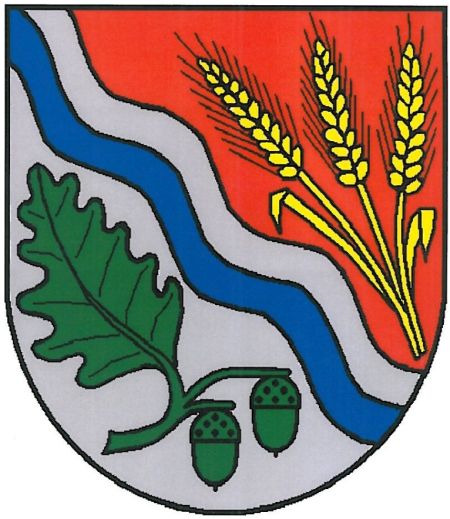Mauel: Difference between revisions
Knorrepoes (talk | contribs) m (Text replacement - "50 px|link=Germany" to "") |
Knorrepoes (talk | contribs) No edit summary |
||
| Line 10: | Line 10: | ||
===Official blazon=== | ===Official blazon=== | ||
Von Rot über Silber geteilt durch schrägrechten blau-silbernen Wellenbalken, vorn grüner Eichenzweig mit einem Blatt und zwei Eicheln, hinten drei goldene Ähren. | |||
===Origin/meaning=== | ===Origin/meaning=== | ||
The arms were officially granted on February 16, 2009. | |||
The wavy bend symbolises the Prüm river. The colours red and silver are those of the Prüm Abbey, to which the village belonged in medieval times. The wheat and the acorn refer to agriculture and forestry, the main economic activities of the village for many centuries. | |||
The oak also refers to the Napoleon Oak, a natural monumnet under which, according to legend, Napoleon (or part of his troops) camped in the early 19th century. | |||
{{media}} | {{media}} | ||
[[Civic Heraldry Literature - Germany|Literature]] : | [[Civic Heraldry Literature - Germany|Literature]] : Info from the VG Arzfeld | ||
[[Category:German Municipalities M]] | [[Category:German Municipalities M]] | ||
| Line 22: | Line 27: | ||
[[Category:Bitburg-Prüm]] | [[Category:Bitburg-Prüm]] | ||
[[Category:Prüm]] | [[Category:Prüm]] | ||
[[Category:Granted 2009]] | |||
Revision as of 09:18, 19 April 2019
This page is part of the German heraldry portal |
Heraldry of the World |
|
German heraldry:
|
Selected collector's items from Germany:
|
MAUEL
State : Rheinland-Pfalz
District (Kreis) : Eifelkreis Bitburg-Prüm (until 1969 Prüm)
Verbandsgemeinde : Verbandsgemeinde Arzfeld
Official blazon
Von Rot über Silber geteilt durch schrägrechten blau-silbernen Wellenbalken, vorn grüner Eichenzweig mit einem Blatt und zwei Eicheln, hinten drei goldene Ähren.
Origin/meaning
The arms were officially granted on February 16, 2009.
The wavy bend symbolises the Prüm river. The colours red and silver are those of the Prüm Abbey, to which the village belonged in medieval times. The wheat and the acorn refer to agriculture and forestry, the main economic activities of the village for many centuries.
The oak also refers to the Napoleon Oak, a natural monumnet under which, according to legend, Napoleon (or part of his troops) camped in the early 19th century.
Contact and Support
Partners:
Your logo here ?
Contact us
© since 1995, Heraldry of the World, Ralf Hartemink 
Index of the site
Literature : Info from the VG Arzfeld













